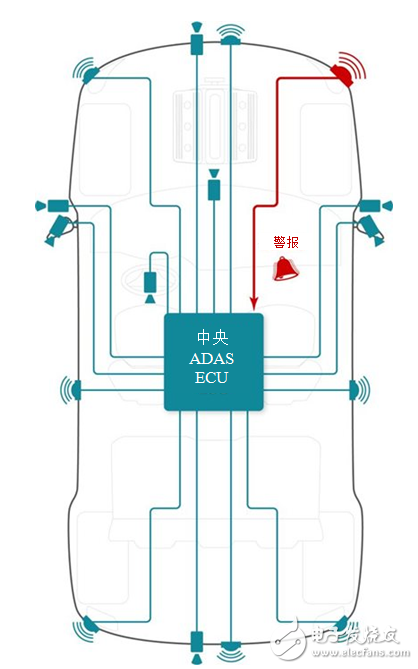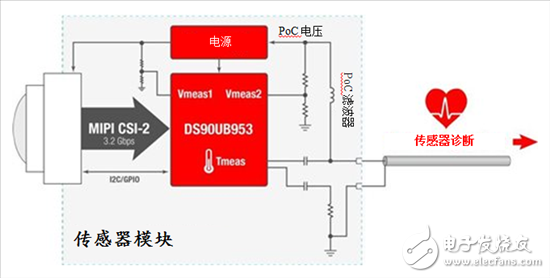Monitoring the status of more and more automotive cameras, radars and other high-speed sensor modules is becoming more complex. While smart sensors with local processors can monitor their own health status, raw data sensors typically lack a local microcontroller that performs this task, allowing the central electronic control unit (ECU) processor to monitor each sensor individually.
However, the raw data sensor does not have to be "mute". Integrating intelligent health monitoring into the serializer and deserializer (SerDes) link chipset prevents the central processor from constantly polling the sensor for operational status. In this blog post, I will take a look at this device.
Multi-Sensor Advanced Driver Assistance System (ADAS)
The next generation of vehicles may have more than a dozen or more remote raw data sensors (Figure 1). Monitoring the health of each sensor increases the software overhead in the central ECU processor. The ECU must monitor factors such as sensor status, module voltage, module temperature, link operation (bidirectional), and other sensors, serializers, deserializers, and other indicators on other chips to generate sensor health. The full picture. You can add a small microcontroller for health monitoring and housekeeping for each remote sensor module, but this adds to the size and cost of the module – the central ECU still has to check each sensor and link separately.
Integrating health monitoring into the SerDes chipset allows centralized monitoring of multiple sensor modules and their links so that the central ECU receives only one unified interrupt warning.

Figure 1: Example of car camera and radar sensor distribution
Link status and protection
The first layer in autonomous sensor monitoring is link integrity itself. The link must provide robust control channels and link data protection and diagnostics. The link monitors cable faults (open, short to ground, short to Vbatt) and bit errors and reports the alarm back to the ECU. Both the forward channel and the reverse channel are monitored for faults by the SerDes chipset. In addition, the DS90UB953-Q1 serializer performs parity checks on the data input of the serializer, allowing the system to determine if the potential error originated from the sensor or from the link. Finally, the deserializer's adaptive equalizer provides cable health quality measurements that enable the system to warn of cable degradation.
Sensor module health diagnosis
As sensors proliferate and system functional safety becomes more important, it is useful to provide some level of health monitoring for individual sensor modules. For example, the DS90UB953-Q1 serializer integrates many features to support this goal (Figure 2). Internally, the serializer monitors its own state, such as lock, active clock, and temperature. The serializer also monitors external health factors such as supply voltage and incoming sensor data errors. A configurable alarm bit sent continuously to the deserializer will warn the ECU if any of the monitored values ​​are out of range. The serializer also reports if there is an error in the control channel communication to the sensor module. If an I2C write error occurs, the serializer does not transmit the wrong I2C command, which helps prevent the sensor module from misconfiguring. The deserializer sends a warning to the central ECU so that the system can take further action, such as controlling data retransmissions.

Figure 2: Example of integrated sensor module health diagnostics
Aggregate health status
Multiple input deserializer hubs (such as the DS90UB960-Q1) integrate the state of up to four sensors into a single programmable open-drain interrupt pin (Figure 3). An alarm sent by any of a number of sensor serializers or links can trigger an interrupt. The local processor then reads the status register to determine the nature and location of the alert. You can configure the deserializer interrupt pin to activate based on multiple programmable variables. Because this pin uses an open-drain structure, you can connect multiple interrupts together (line OR'd) to combine interrupts from multiple chips, saving processor I/O pins.

Figure 3: Deserializer Center aggregates alarms from multiple sensor links
Smart sensor health
More and more high-speed sensors are being used in cars, which has led to autonomous driving. Today's raw data sensors can be combined with health monitoring capabilities to remotely and autonomously monitor faults, save processor resources and provide additional system protection. This makes these "health smart" modules easier to deploy the larger number of high speed sensors needed for future vehicles. For more information, check out TI's entire ADAS application.
other information
Also consider the DS90UB954-Q1 dual FPD-Link III deserializer hub.
Pair one of our deserializer hubs with the TDA3x System on Chip (SoC) processor for ADAS.
Vc Enzyme Combo Repair Shampoo
Orange has a fragrant shampoo having stable paste consistency suitable, white color, lasting aroma characteristics, have a good effect hair care and hair fixed.
Companies registered capital of 35 million yuan, the end of 2014 the total assets of 48.69 million yuan, including fixed assets of 37.52 million yuan. The company's existing cooperation Orange cultivation base 7043.5 acres, the company production base is located in Jiangxi County Tech Industrial Park Chu Tan industrial area, covers an area of 120 acres, it has built a standard plant 9,000 square meters, Nissan 6000 kg Orange enzymes and other liquid enzyme products. Enzyme, known as enzyme, refers to a polymer substance having biocatalytic functionality. In the catalytic reaction system an enzyme, the reactant molecules are known as substrates, enzyme substrates by catalytic conversion to another molecule. Almost all cellular activity of enzymes involved in the process are required to improve efficiency. Similar to other non-biological catalysts, enzymes chemical reactions by lowering the activation energy to accelerate the rate of the reaction, most of the enzyme catalyzed reaction rate can be increased a million times; in fact, the enzyme is to provide an activation energy needs than another low way, so that more particles to have less than the activation energy of the reaction kinetic energy, thus speeding up the reaction rate. Enzyme as a catalyst, in itself is not consumed during the reaction, it does not affect the chemical equilibrium reactions. Positive enzyme catalysis, but also a negative catalytic effect, not only to accelerate the reaction rate, but also to reduce the reaction rate. And other non-living catalysts is different, having a high degree of specificity of enzyme, only a catalytic reaction or produce a particular specific configuration.
Vc Enzyme Combo Repair Shampoo,Orange Aromatic Flavor Enzyme Shampoo,Hair Repair Enzymes Shampoo,Clean Hair Scalp Enzyme Shampoo
Ganzhou Green days Biochemical Technology Co., Ltd. , https://www.cn-gangdao.com